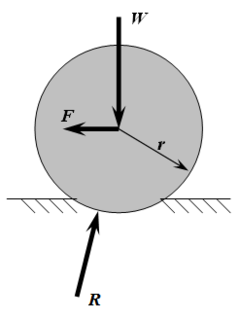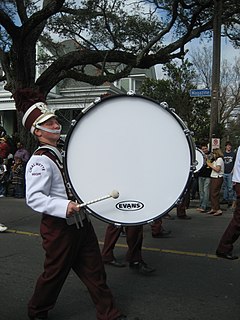
Acoustics is a branch of physics that deals with the study of mechanical waves in gases, liquids, and solids including topics such as vibration, sound, ultrasound and infrasound. A scientist who works in the field of acoustics is an acoustician while someone working in the field of acoustics technology may be called an acoustical engineer. The application of acoustics is present in almost all aspects of modern society with the most obvious being the audio and noise control industries.

Friction is the force resisting the relative motion of solid surfaces, fluid layers, and material elements sliding against each other. There are several types of friction:

An inelastic collision, in contrast to an elastic collision, is a collision in which kinetic energy is not conserved due to the action of internal friction.
Tribology is the science and engineering of interacting surfaces in relative motion. It includes the study and application of the principles of friction, lubrication and wear. Tribology is highly interdisciplinary, drawing on many academic fields, including physics, chemistry, materials science, mathematics, biology and engineering. People who work in the field of tribology are referred to as tribologists.
Torsional vibration is angular vibration of an object—commonly a shaft along its axis of rotation. Torsional vibration is often a concern in power transmission systems using rotating shafts or couplings where it can cause failures if not controlled. A second effect of torsional vibrations applies to passenger cars. Torsional vibrations can lead to seat vibrations or noise at certain speeds. Both reduce the comfort.

Rolling resistance, sometimes called rolling friction or rolling drag, is the force resisting the motion when a body rolls on a surface. It is mainly caused by non-elastic effects; that is, not all the energy needed for deformation of the wheel, roadbed, etc., is recovered when the pressure is removed. Two forms of this are hysteresis losses, and permanent (plastic) deformation of the object or the surface. Note that the slippage between the wheel and the surface also results in energy dissipation. Although some researchers have included this term in rolling resistance, some suggest that this dissipation term should be treated separately from rolling resistance because it is due to the applied torque to the wheel and the resultant slip between the wheel and ground, which is called slip loss or slip resistance. In addition, only the so-called slip resistance involves friction, therefore the name "rolling friction" is to an extent a misnomer.

A piezoelectric motor or piezo motor is a type of electric motor based on the change in shape of a piezoelectric material when an electric field is applied, as a consequence of the converse piezoelectric effect. An electrical circuit makes acoustic or ultrasonic vibrations in the piezoelectric material, most often lead zirconate titanate and occasionally lithium niobate or other single-crystal materials, which can produce linear or rotary motion depending on their mechanism. Examples of types piezoelectric motors include inchworm motors, stepper and slip-stick motors as well as ultrasonic motors which can further be further categorized into standing wave and travelling wave motors. Piezoelectric motors typically use a cyclic stepping motion, which allows the oscillation of the crystals to produce an arbitrarily large motion, as opposed to most other piezoelectric actuators where the range of motion is limited by the static strain that may be induced in the piezoelectric element.

An adhesion railway relies on adhesion traction to move the train. Adhesion traction is the friction between the drive wheels and the steel rail. The term "adhesion railway" is used only when it is necessary to distinguish adhesion railways from railways moved by other means, such as by a stationary engine pulling on a cable attached to the cars or by railways that are moved by a pinion meshing with a rack.

In mechanics, an impact is a high force or shock applied over a short time period when two or more bodies collide. Such a force or acceleration usually has a greater effect than a lower force applied over a proportionally longer period. The effect depends critically on the relative velocity of the bodies to one another.

In physics, rotational–vibrational coupling occurs when the rotation frequency of a system is close to or identical to a natural internal vibration frequency. The animation on the right shows ideal motion, with the force exerted by the spring and the distance from the center of rotation increasing together linearly with no friction.
The stick-slip phenomenon, also known as the slip-stick phenomenon or simply stick-slip, is the spontaneous jerking motion that can occur while two objects are sliding over each other.
Coulomb damping is a type of constant mechanical damping in which the system's kinetic energy is absorbed via sliding friction. Coulomb damping is a common damping mechanism that occurs in machinery.
Statistical energy analysis (SEA) is a method for predicting the transmission of sound and vibration through complex structural acoustic systems. The method is particularly well suited for quick system level response predictions at the early design stage of a product, and for predicting responses at higher frequencies. In SEA a system is represented in terms of a number of coupled subsystems and a set of linear equations are derived that describe the input, storage, transmission and dissipation of energy within each subsystem. The parameters in the SEA equations are typically obtained by making certain statistical assumptions about the local dynamic properties of each subsystem. These assumptions significantly simplify the analysis and make it possible to analyze the response of systems that are often too complex to analyze using other methods.

A gyroscopic exercise tool is a device used to exercise the wrist as part of physical therapy or in order to build palm, forearm and finger strength. It can also be used as a unique demonstration of some aspects of rotational dynamics. The device consists of a tennis ball-sized plastic or metal shell around a free-spinning mass, which is started with a short rip string. Once the gyroscope inside is going fast enough, a person holding the device can accelerate the spinning mass to high revolution rates by moving the wrist in a circular motion.

In physics, sound is a vibration that propagates as an acoustic wave, through a transmission medium such as a gas, liquid or solid. In human physiology and psychology, sound is the reception of such waves and their perception by the brain. Only acoustic waves that have frequencies lying between about 20 Hz and 20 kHz, the audio frequency range, elicit an auditory percept in humans. In air at atmospheric pressure, these represent sound waves with wavelengths of 17 meters (56 ft) to 1.7 centimeters (0.67 in). Sound waves above 20 kHz are known as ultrasound and are not audible to humans. Sound waves below 20 Hz are known as infrasound. Different animal species have varying hearing ranges.

A wind instrument is a musical instrument that contains some type of resonator in which a column of air is set into vibration by the player blowing into a mouthpiece set at or near the end of the resonator. The pitch of the vibration is determined by the length of the tube and by manual modifications of the effective length of the vibrating column of air. In the case of some wind instruments, sound is produced by blowing through a reed; others require buzzing into a metal mouthpiece, while yet others require the player to blow into a hole at an edge, which splits the air column and creates the sound.
In the context of classical mechanics simulations and physics engines employed within video games, collision response deals with models and algorithms for simulating the changes in the motion of two solid bodies following collision and other forms of contact.

João Arménio Correia Martins was born on November 11, 1951, at the southern town of Olhão in Portugal. He attended high school at the Liceu Nacional de Faro which he completed in 1969. Afterwards João Martins moved to Lisbon where he was graduate student of Civil Engineering at Instituto Superior Técnico (IST) until 1976. He was a research assistant and assistant instructor at IST until 1981. Subsequently, he entered the graduate school in the College of Engineering, Department of Aerospace Engineering and Engineering Mechanics of The University of Texas at Austin, USA. There he obtained a MSc in 1983 with a thesis titled A Numerical Analysis of a Class of Problems in Elastodynamics with Friction Effects and a PhD in 1986 with a thesis titled Dynamic Frictional Contact Problems Involving Metallic Bodies, both supervised by Prof. John Tinsley Oden. He returned to Portugal in 1986 and became assistant professor at IST. In 1989 he became associate professor and in 1996 he earned the academic degree of “agregado” from Universidade Técnica de Lisboa. Later, in 2005, he became full professor in the Department of Civil Engineering and Architecture of IST.
Structural acoustics is the study of the mechanical waves in structures and how they interact with and radiate into adjacent media. The field of structural acoustics is often referred to as vibroacoustics in Europe and Asia. People that work in the field of structural acoustics are known as structural acousticians. The field of structural acoustics can be closely related to a number of other fields of acoustics including noise, transduction, underwater acoustics, and physical acoustics.
Contact mechanics is the study of the deformation of solids that touch each other at one or more points. This can be divided into compressive and adhesive forces in the direction perpendicular to the interface, and frictional forces in the tangential direction. Frictional contact mechanics is the study of the deformation of bodies in the presence of frictional effects, whereas frictionless contact mechanics assumes the absence of such effects.











